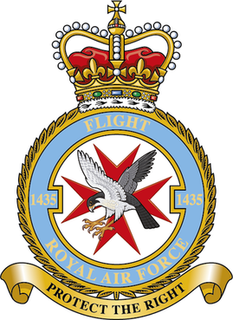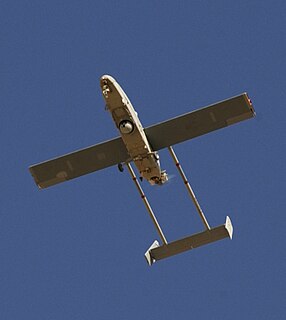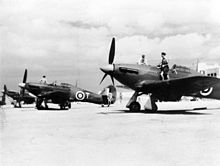
The Desert Air Force (DAF), also known chronologically as Air Headquarters Western Desert, Air Headquarters Libya, the Western Desert Air Force, and the First Tactical Air Force (1TAF), was an Allied tactical air force created from No. 204 Group RAF under RAF Middle East Command in North Africa in 1941 to provide close air support to the British Eighth Army against Axis forces. Throughout the Second World War, the DAF was made up of squadrons from the Royal Air Force (RAF), the South African Air Force (SAAF), the Royal Australian Air Force (RAAF), the United States Army Air Forces (USAAF) and other Allied air forces.

No. 1435 Flight is a Typhoon FGR. 4 unit of the Royal Air Force, based at RAF Mount Pleasant, providing air defence for the Falkland Islands, South Georgia and the South Sandwich Islands. Permanently based in the islands, the aircrew and groundcrew from the UK are cycled through No. 1435 Flight, providing a 365-day, 24-hour alert.

1 Squadron SAAF was an air force squadron of the South African Air Force and was formed at Air Force Station Swartkop in February 1920, equipped with De Havilland DH.9's part of the Imperial Gift donation to South Africa by Britain. On 31 August 1939 the squadron was re-designated as 1 Bomber/Fighter Squadron and this was then changed to 11 (Bomber) Squadron in December 1939. The squadron was resurrected in February 1940 by the renumbering of 6 Squadron, equipped with four Hurricane Mk 1's and six Furies.

No. 78 Squadron of the Royal Air Force, is the squadron number plate of RAF (Unit) Swanwick based at London Area Control Centre, Swanwick, Hampshire. The squadron was allocated the role in early 2021.
No. 118 Squadron was a squadron of the British Royal Air Force. Originally formed in 1918, it served as a fighter squadron in the Second World War, flying Spitfires and Mustangs. It flew jet fighters as part of RAF Germany in the 1950s, and Bristol Sycamore helicopters in Northern Ireland before finally disbanding in 1962.

40 Squadron SAAF existed as a combat unit from early 1940 through to late 1945. It served in the East African Campaign, Western Desert, Tunisia, and Italy, reaching Austria by the end of World War II. The squadron's motto in those years was Amethlo e Impi – the eyes of the army.

No. 106 Squadron RAF was a Royal Flying Corps and Royal Air Force squadron active from 1917 until 1919, throughout World War II and during the Cold War from 1959 until 1963.
No. 242 Squadron RAF was a Royal Air Force (RAF) squadron. It flew in many roles during the First World War, Second World War and Cold War.
Royal Air Force Thornaby or more simply RAF Thornaby was a former Royal Air Force Station located near the town of Thornaby-on-Tees, in the North Riding of Yorkshire, England. Fighter Command, Bomber Command and Coastal Command all operated from the base over its history, but its stint under Coastal Command is what the base was notable for, particularly in the air-sea rescue environment and the development of the Thornaby Bag. This was an emergency bag dropped to downed aircrew at sea and contained food, cigarettes and drink.
No. 225 Squadron RAF is a former Royal Air Force squadron.
Number 76 Squadron was a squadron of the Royal Air Force. It was formed during World War I as a home defence fighter squadron and in its second incarnation during World War II flew as a bomber squadron, first as an operational training unit and later as an active bomber squadron. With the end of the war the squadron converted to the role of transport squadron, to be reactivated shortly in the bomber role during the 1950s. From 2007 to 2011, it was a training unit, equipped with the Short Tucano at RAF Linton-on-Ouse.
No. 608 Squadron was an Auxiliary Air Force squadron of the Royal Air Force during the Second World War. It flew during its existence as a bomber, fighter and reconnaissance unit and was the only RAF squadron to be equipped with the unsuccessful Blackburn Botha torpedo bomber.
No. 229 Squadron RAF was a squadron of the Royal Air Force, and is an officially accredited Battle of Britain Squadron. It became No. 603 Squadron RAF in January 1945.
No. 126 Squadron RAF was a Royal Air Force Squadron formed to be a day bomber unit in World War I and reformed as a fighter unit in World War II.
No. 131 Squadron RAF was a Royal Air Force Squadron formed to be a bomber unit in World War I and reformed as a fighter unit in World War II.
No. 154 Squadron RAF was a Royal Air Force squadron formed as a fighter unit in the Second World War.

7 Squadron was a unit of the South African Air Force which served in the Second World War as well as in South Africa between 1951 and 1992. During the war, the squadron was used as a fighter squadron deployed to the Western Desert as well as in the Aegean, Italy and Ceylon. The squadron was inactive from the end of the war until 1951 when it re-activated as a citizen force training squadron, a role it retained during two periods of active service until 1992, when it was disbanded for the last time.

10 Squadron was a squadron of the South African Air Force. It was formed as a fighter bomber unit on 1 April 1939 and was deployed in a coastal defence role as part of Coastal Command SAAF until 1943. It was disbanded after the threat of Japanese naval actions off the South African coast had waned. It was re-activated as a fighter squadron on 25 May 1944 and deployed to the Middle East where the squadron saw service in Syria, Libya and the Aegean and was disbanded at the end of the war in Italy.

11 Squadron was a World War II squadron of the South African Air Force. It was created in South Africa in 1939 and served in East Africa until 1941 as an army cooperation and reconnaissance squadron. It was re-formed in 1944 as a fighter bomber squadron and served in Italy until 1945 when it returned to Egypt and was disbanded on conclusion of the war on 30 October 1945. It was re-activated in 1974, flying Cessna 185s as an army liaison squadron until 1991 when it disbanded for the final time.

885 Naval Air Squadron was a Naval Air Squadron of the Royal Navy's Fleet Air Arm. First formed on 1 March 1941, the squadron served as a fighter squadron during the Second World War. It operated in the Mediterranean in 1942–43, where it took part in Operation Torch, the Anglo-American invasion of French North Africa, the Allied invasion of Sicily and the Allied invasion of Italy. In 1944 it took part in the Allied invasion of Normandy, spotting for Allied artillery bombardments and in 1945, was deployed as part of the British Pacific Fleet. It was abolished for the last time on 27 September 1945.











